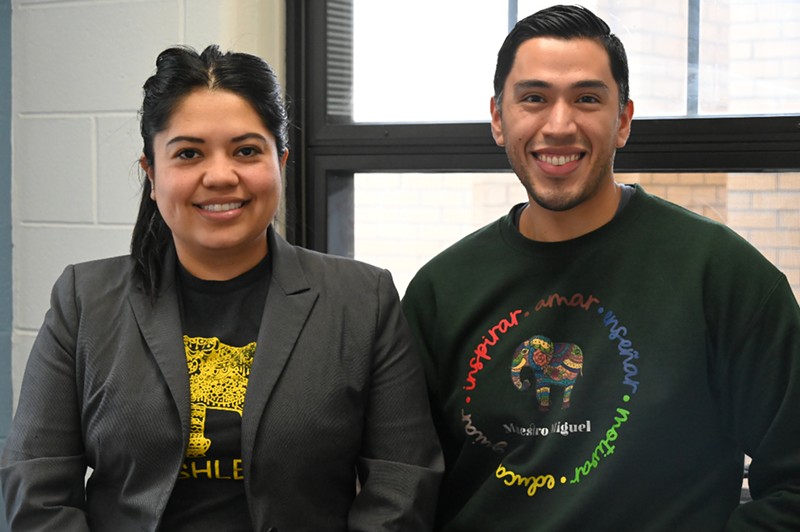"We started to slowly see more and more enrollment. When we got over 200, we were super excited because we were over projection," Estrada says. "And then the first two weeks of school was when we really saw a jump in enrollment, and from then on out, it was about eight to ten enrollments a week."
In late December, Ashley Elementary finished the semester with about 400 students, including 240 native Spanish speakers — with "the majority of those being migrant students," Estrada says.
While the number of students enrolled in Colorado schools dropped for the third straight year in 2023 — by about 1,800 students, according to data just published by the Colorado Department of Education on Wednesday — enrollment is up at Denver Public Schools.
A flood of migrants, mostly from Venezuela, has been pouring into Denver for more than a year, overwhelming city services. Mayor Mike Johnston is headed to Washington, D.C., for an annual mayors' conference this week; to get help for Denver and other cities dealing with the migrant crisis, he plans to push Congress and the White House for "increased work authorization, a coordinated entry program, and more federal dollars for cities," according to his office.
Nearly 38,000 migrants have come to Denver since December 2022. While many have moved on, sometimes being given bus and even plane tickets by the city to go to their desired locations, others have stayed in Denver. By mid-January, the number of migrants in Denver shelters almost reached 5,000, a new high, as the city scrambled to move people sleeping on the streets out of the cold.
Schools like Ashley Elementary have felt the impact of those numbers as young migrants move into schoolrooms.
Miguel Fittoria, a first-grade teacher at Ashley, had thirteen students on his roster before the fall semester. When the school year started, it grew to eighteen students; six weeks later, Fittoria had 32 students in his class. Estrada solved the problem by splitting the classroom and shifting Fittoria to the role of an English Language Acquisition, or ELA, teacher, because so many of the new students only spoke Spanish.
Instruction in Fittoria's class is now 80 percent in Spanish to meet district guidelines. “Let’s do this, I love it," he says. "The families need somebody to support them, to help them, and I wanted to jump in. These are students I want to keep safe, I want to have them be happy, I want them on top of everything else feeling like this is their home.”
Fittoria's new class started with twenty students and ended last semester with 27.
Now, three weeks into the spring semester, enrollment at Ashley continues to climb. The first week, it had ten new enrollments, the second week five more.
Even before the new enrollments, Ashley Elementary's student population was 60 percent Hispanic and the school offered bilingual services — a draw for migrants, according to Adrienne Endres, executive director of multilingual education for DPS.
DPS has about 37,000 multilingual students; among them, they speak more than 200 different languages, but about 80 percent speak Spanish. The district does not track which students are migrants, but from July 1 to January 5, DPS enrolled about 2,400 "new to the country" students, according to Endres. The district had only enrolled about 1,500 "new to the country" students for the entire year before that.
Miguel Fittoria, a first-grade teacher at Ashley, had thirteen students on his roster before the fall semester. When the school year started, it grew to eighteen students; six weeks later, Fittoria had 32 students in his class. Estrada solved the problem by splitting the classroom and shifting Fittoria to the role of an English Language Acquisition, or ELA, teacher, because so many of the new students only spoke Spanish.
Instruction in Fittoria's class is now 80 percent in Spanish to meet district guidelines. “Let’s do this, I love it," he says. "The families need somebody to support them, to help them, and I wanted to jump in. These are students I want to keep safe, I want to have them be happy, I want them on top of everything else feeling like this is their home.”
Fittoria's new class started with twenty students and ended last semester with 27.
Now, three weeks into the spring semester, enrollment at Ashley continues to climb. The first week, it had ten new enrollments, the second week five more.
Even before the new enrollments, Ashley Elementary's student population was 60 percent Hispanic and the school offered bilingual services — a draw for migrants, according to Adrienne Endres, executive director of multilingual education for DPS.
DPS has about 37,000 multilingual students; among them, they speak more than 200 different languages, but about 80 percent speak Spanish. The district does not track which students are migrants, but from July 1 to January 5, DPS enrolled about 2,400 "new to the country" students, according to Endres. The district had only enrolled about 1,500 "new to the country" students for the entire year before that.
"As we continue to receive buses from states with migrants, many have families, and we welcome them into DPS," Endres says. "Having a new student from a Spanish-speaking country is nothing new to DPS. We're built around and for those students. It just has been the rate and frequency at which they've been arriving that has been more of a challenge."
DPS has “been experiencing declining enrollment for several years, particularly with our Spanish-speaking population,” she notes, so she sees the arriving migrant students as an opportunity to fill up classrooms.
“This is very exciting for our bilingual program to get this boost of life and energy,” Endres adds. “We have some schools that are underenrolled or have smaller enrollment that have space in them, so even if we get to the point where we’ve had to open new classrooms, we can take overflow kids to new places. We have within the district I think we can continue supplying physical space for students.”
Denver has ten migrant shelters, most of them closer to the edges of the city, near Tower Road to the east and Federal Boulevard to the west. DPS staff will go to shelters to enroll students, Endres says; as a result, schools in the northwestern part of Denver have also been impacted.
Valdez Elementary, Lake Middle School and North High School are all close to shelters, and migrants who lived at the encampment recently cleared near Speer Boulevard and Zuni Street say they enrolled their students at these schools.
Valdez Elementary, Lake Middle School and North High School are all close to shelters, and migrants who lived at the encampment recently cleared near Speer Boulevard and Zuni Street say they enrolled their students at these schools.
"We see students enrolling initially where shelters are," Endres says. "Parents get to choose what programming option they'd like for their students, so if the neighborhood school at which they would enroll doesn't offer the program that they're seeking, then DPS works with them to find one that does and provides transportation."
Because it offers transportation, DPS has seen the biggest increase in migrant enrollment at schools in the southeastern part of the city and near Monaco Street, including Place Bridge and McMeen Elementary, Denver Green K-8 School and George Washington High School, all of which offer bilingual services or native language support.
Ashley Elementary doesn't know where the migrant students came from, Estrada says. Only one migrant shelter is located within five miles of the school, and 200 are staying at that shelter, according to the city. The area's population is 26 percent Hispanic.
Ashley Elementary doesn't know where the migrant students came from, Estrada says. Only one migrant shelter is located within five miles of the school, and 200 are staying at that shelter, according to the city. The area's population is 26 percent Hispanic.
Both Estrada and Fittoria were new to Ashley Elementary last fall. Estrada had been the assistant principal at College View Elementary School before taking the job as Ashley's interim principal, after the last principal took an "upgraded position in another district," according to DPS.
When Fittoria was hired in the fall, he stepped into his first full-time teaching position. He didn't expect the challenges he faced in his initial semester, but "I’m excitedly ready for more,” he says.
Estrada is satisfied with the way her school has responded to the unexpected burst of enrollment. Although Estrada has "been able to get everything I need" from DPS, she could still use “a bigger pool of bilingual applicants, or mental health positions or any positions," and "any teacher would say more funding is nice," she notes.
“We have hired new teachers and opened up new classrooms to be able to maintain more than 400 students,” she says. “We did get new moneys from fall adjustment [in September] and October count, so we’re at a place now where it has become more sustainable.”
The City of Denver, however, "needs to do a better job communicating with schools around where are these shelters located, where are the migrant students living, how many students should we expect to be enrolling,” Estrada suggests.
"To be completely fair, though, I don’t think the district knew, either. None of us knew, but I think moving forward we have this experience," she adds. “Now I think we’re starting to see everything fall into place."
The City of Denver, however, "needs to do a better job communicating with schools around where are these shelters located, where are the migrant students living, how many students should we expect to be enrolling,” Estrada suggests.
"To be completely fair, though, I don’t think the district knew, either. None of us knew, but I think moving forward we have this experience," she adds. “Now I think we’re starting to see everything fall into place."
Returning Ashley Elementary students have been friendly to the new students, Estrada says. When one child from Venezuela couldn't figure out the water fountain because he'd never used one before, other students eagerly showed their classmate how it works, she recalls.
Fittoria says the students in his class have been welcoming, too. “They love it,” Fittoria says. “Children are so much better than we are about inviting new kids into their space, because they have no preconceived notions about the challenge. They just think, ‘Oh, a new friend!’”
Fittoria says the students in his class have been welcoming, too. “They love it,” Fittoria says. “Children are so much better than we are about inviting new kids into their space, because they have no preconceived notions about the challenge. They just think, ‘Oh, a new friend!’”
This story has been updated to include new information on student enrollment across Colorado.












